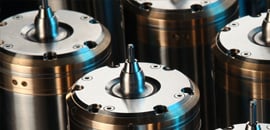kB being the bearing stiffness, itself variable with speed and temperature.
k1… kN being the stiffness of all individual components, joints, mechanisms, etc. between the bearing a rigid ground.
The result of this may be seen as an effect on system dynamic performance (whirl speeds), or on resonance frequencies or harmonics. The shaft will also experience machine-induced spindle movements (intentional or otherwise) through the bearing ‘spring’ system. This further complicates the calculation of dynamic effects.
In an application where it is known that the spindle will be subject to controlled, externally produced, movements (e.g. drilling, spraying, etc.), it is necessary to estimate the bearing loading produced by shaft gyroscopic or inertia effects, resulting from this action. Most spindle outline specifications, as well as theoretical and test performances, consider the spindle in isolation (example: unaffected by external stimuli). It is therefore necessary to establish the angular and linear accelerations acting on the system before calculating the forces involved.
As the distances between shaft and bearing are so small, and the time requirements to move these distances are very short, it is necessary to consider all changes in acceleration (jerk) experienced by the spindle. It is best to measure the effects of such actions at the shaft with the spindle mounted in the machine to be used, as calculation can be very difficult. Typical control movement accelerations are in the order of 1G to 5G, but system clearances, backlash, bounce, and resonance can create two to ten times this value at the spindle. A major problem associated with excessive acceleration, or applied vibration, is that it is one of the very few mechanisms that can cause minor damage to a bearing, and hence cause a degradation of performance over a period of time.
Although of very small frictional resistance, gas film shearing will produce some heat at high rotational speeds. This will be dissipated by the cooling system but some minor performance changes may occur in the first few seconds after start-up (all theoretical design and practical testing is based on stable dynamic conditions).
On machines with multiple spindles, it should be noted that ‘Brinelling’ (localized bearing damage caused by sympathetic vibration of the static shaft) could result from long-term isolation of one or more spindles.











